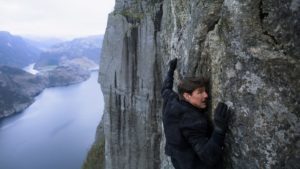
Kurt Walker’s excellent documentary feature Hit 2 Pass starts off with black-and-white footage of a jittery, cackling man surrounded by strips of film. He proceeds to excitedly tell the camera that the following film will be shown in 4:3. Wait, isn’t this a documentary? Is this man the film’s editor? Why does he sound so passionate about the movie’s aspect ratio? Before any of those questions are answered, the film cuts to colour footage of a highway. A car slows down and stops to pick up a hitch-hiker. The man, who is standing comically far away from the curb, holding a crude cardboard sign that says “Prince George” on it, is our man from the previous scene. He gets into the car, and the whole crew drives on over to Prince George, British Colombia to the tune of glitched-out 16-bit jams. So begins this unique little ethnographic road movie that doubles as an intimate look at the moving parts of a fictional/social/personal narrative.
Ostensibly, Hit 2 Pass is about Tyson Storozinski, his dad Dale, and their participation in the Prince George Auto Racing Association’s fall hit-to-pass competition, which is essentially a combination auto race and demolition derby where a driver must hit a car before they can pass it. The first act of the film is dedicated to finding and restoring a scrapheap to raceday-ready status. The atmosphere is all small-town affability and thick-sliced hoser accents. This alone would make a fascinating feature, but Walker ups the ante by making the assembly of the film just as interesting as the assembling of the Storozinkis’ hot rod. Segments organically trail off where other docs would cut. Off-screen questions and banter are left in. Many sequences look like abstract geometrical compositions scored by field recordings. Rather than make the film feel sloppy, they invigorate Hit 2 Pass with an vibrant sense of playfulness. In fact, play is one of the threads that ties the film together. An entire sequence is composed to footage taken from a RC drone camera (the look on the crew’s faces while they’re playing around with it are priceless). A kid filming the track on race day drops his handheld camera, apologizes to the presumed audience, and proceeds to shoot the track through a pair of binoculars. It’s as fresh and vital as verité cinema can conceivably get.
Other than verité cinema and ethnographic-style explorations, Hit 2 Pass gets a lot of its visual edge from video games. The opening credits are spliced with footage of people playing Road Rash. A before/after shot of the Storozinskis’ hot rod feels lifted straight from the vehicle selection screen from Gran Turismo. The link with the rest of the film seems tenuous at first, and then reveals itself to be integral by the end of the film’s running time. Hit 2 Pass isn’t just about building a car, or the joys of fucking around, but it acts as an exploded view of storytelling, and its nature as collaborative and participatory. Over the course of its running time, it breaks down the documentary form into its most base constituent parts (the talking head, abstract ethnography, character study, etc) and turns them on their ears. It goes from having a narrative, abstracted as it may be, to examining the very concept of narrative. In its first act, Hit 2 Pass is a chronicling of the building and racing of a car; by act two, it morphs into a closer examination of how community and storytelling are intertwined.
In this second part of the triptych, Walker interviews local newspaper columnist Nathan Giebe. He doesn’t say his name, nor are we told anything about his job, but we come to learn plenty about his past. Giebe, a member of the First Nations, was raised by a white family in BC. The story itself is quite stirring; he talks at length about identity and tradition, both his and others. But what the hell does it have to do with race cars? That’s the genius of Hit 2 Pass: each subsequent sections helps cast light onto the previous one. By robbing this particular interview segment of context, it gives context to the film up to that point. What the Storozinskis were engaging in is a souped-up kind of tradition, a community event with a history and a following. The fizzling fireworks and muffled Black Eyed Peas jams go from being a magnificently abstracted of a night out in a small town and become part of a greater community narrative, which in turn is composed of smaller narratives where people go to scrap yards and make movies with their friends. The third part of the Hit 2 Pass triptych features museum exhibits, graffiti, and video games, and how the narratives in those media exist in a push-pull with greater social narratives, while in this case simultaneously engaging with the multiple narrative strains of the film itself. Ultimately, Hit 2 Pass ended up being what I wish Goodbye to Language had been: a visually-inventive dismantling of the meaning of narrative that was also warm, fun, and engaging.
—
Hit 2 Pass is in extremely limited release at the moment. Keep your eyes peeled for in on the festival circuit in 2015.
Directed by Kurt Walker; written by Neil Bahadur, John Lehtonen, Tyson Storozinski, and Kurt Walker; starring Neil Bahadur, Dale Storozinski, Nathan Giede, and Dale Storozinski; 72 minutes.



 Derek
Derek
 Isabelle
Isabelle